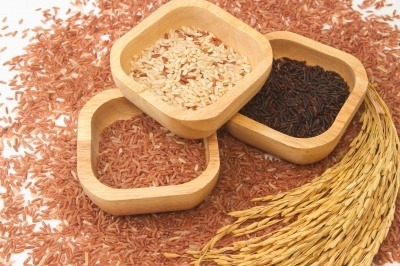
Rice (Oryza sativa L.) is a staple food and a valuable economic crop of many countries including India, China, Japan and Thailand. A group of varieties of special interest are the pigmented rice cultivars, particularly red and black rice which are now grown widely. They provide considerable dietary interest and make for spectacular additions to cuisine.
Components In Pigmented Rice
Pigmented rice is a rich source of phytonutrients including various polyphenols and antioxidants which have a variety of health benefits (Chen & Bergman, 2005; Yawadio et al., 2007). Of these, red and black rice cultivars have a higher antioxidant activity and phenolic content than their non-pigmented counterparts (Ryu et al., 1998; Ling et al., 2001; Hu et al., 2003; Zhang et al., 2010). Early studies in rabbit models looked at the reduction of cardiovascular events (Ling et al., 2001) with red and black rice and these are being assessed in human clinical studies. These same anthocyanin pigments are extracted in rice wines with some of those health benefits potentially being translated into this product.
The anthocyanins which are found in the pericarp of black rice, have been stated to reduce cholesterol levels in human clinical studies (Lee et al., 2008) and at the biochemical level to inhibit the metabolic enzyme, aldose reductase this is implicated in diabetes (Yawadio et al., 2007). Additionally, the pigmented rice extracts effectively decrease oxidative stress and inflammation as well as atherosclerotic lesion in a mouse study (Ling et al., 2001; Xia et al., 2003).
Please also consider rice bran oil and the bran itself because each pigmented rice will have a corresponding bran, full of oil and a chemical called γ-oryzanol.
References
Chen, M.H. & Bergman, C.J. (2005). A rapid procedure for analysing rice bran tocopherol, tocotrienol and γ-oryzanol contents. J. Food Compos. Anal., 18, pp. 319–331
Hu, C., Zawistowski, J., Ling, W. & Kitts, D.D. (2003). Black rice (Oryza sativa L. indica) pigmented fraction suppresses both reactive oxygen species and nitric oxide in chemical and biological model systems. J. Agric. Food Chem., 51, pp. 5271–5277.
Lee, J.C., Kim, J.D., Hsieh, F.H. & Eun, J.B. (2008). Production of black rice cake using ground black rice and medium-grain brown rice. Int. J. Food Sci. Technol., 43, pp. 1078–1082.
Ling, W.H., Cheng, Q.X., Ma, J. & Wang, T. (2001). Red and black rice decrease atherosclerotic plaque formation and increase antioxidant status in rabbits. J. Nutr., 131, pp. 1421–1426.
Ryu, S.N., Park, S.Z. & Ho, C.T. (1998). High performance liquid chromatographic determination of anthocyanin pigments in some varieties of black rice. J. Food Drug Anal. , 6, pp. 729–736.
Xia, M., Ling, W.H., Ma, J., Kitts, D.D. & Zawistowski, J. (2003). Supplementation of diets with the black rice pigment fraction attenuates atherosclerotic plaque formation in apolipoprotein e deficient mice. J. Nutr., 133, pp. 744–751.
Yawadio, R., Tanimori, S. & Morita, N. (2007). Identification of phenolic compounds isolated from pigmented rices and their aldose reductase inhibitory activities. Food Chem., 101, pp. 1616–1625.
Zhang, M.W., Zhang, R.F., Zhang, F.X. & Liu, R.H. (2010). Phenolic profiles and antioxidant activity of black rice bran of different commercially available varieties. J. Agric. Food Chem., 14, pp. 7580–7587.


Leave a Reply